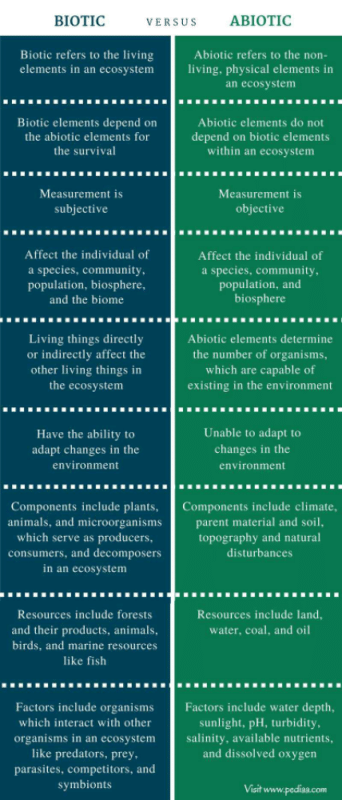Class 9 Exam > Class 9 Questions > Give the difference between biotic and abioti...
Start Learning for Free
Give the difference between biotic and abiotic component?
Most Upvoted Answer
Give the difference between biotic and abiotic component?

Community Answer
Give the difference between biotic and abiotic component?
Biotic vs Abiotic Components
There are two main components of an ecosystem: biotic and abiotic. The biotic component of an ecosystem is made up of all the living organisms that exist within it, while the abiotic component is made up of all the non-living components.
Biotic Component
The biotic component of an ecosystem is made up of all the living organisms that exist within it. These organisms interact with each other and with the non-living components of the ecosystem. Examples of biotic components include:
- Plants
- Animals
- Fungi
- Bacteria
These organisms play an important role in the ecosystem by providing food, shelter, and other resources for each other. They also help to maintain the balance of the ecosystem by consuming and decomposing other organisms.
Abiotic Component
The abiotic component of an ecosystem is made up of all the non-living components. These components include:
- Water
- Soil
- Air
- Sunlight
- Temperature
These components are important for the survival of living organisms in the ecosystem. For example, water is essential for the growth of plants and animals, while sunlight is necessary for photosynthesis to occur.
Difference between Biotic and Abiotic Components
The main difference between biotic and abiotic components is that biotic components are living organisms, while abiotic components are non-living components. Other differences include:
- Biotic components interact with each other, while abiotic components do not.
- Biotic components are capable of growth and reproduction, while abiotic components are not.
- Biotic components are affected by environmental changes, while abiotic components are not.
In summary, both biotic and abiotic components are important for the survival of an ecosystem. They interact with each other to maintain the balance of the ecosystem and ensure the survival of all the living organisms within it.
There are two main components of an ecosystem: biotic and abiotic. The biotic component of an ecosystem is made up of all the living organisms that exist within it, while the abiotic component is made up of all the non-living components.
Biotic Component
The biotic component of an ecosystem is made up of all the living organisms that exist within it. These organisms interact with each other and with the non-living components of the ecosystem. Examples of biotic components include:
- Plants
- Animals
- Fungi
- Bacteria
These organisms play an important role in the ecosystem by providing food, shelter, and other resources for each other. They also help to maintain the balance of the ecosystem by consuming and decomposing other organisms.
Abiotic Component
The abiotic component of an ecosystem is made up of all the non-living components. These components include:
- Water
- Soil
- Air
- Sunlight
- Temperature
These components are important for the survival of living organisms in the ecosystem. For example, water is essential for the growth of plants and animals, while sunlight is necessary for photosynthesis to occur.
Difference between Biotic and Abiotic Components
The main difference between biotic and abiotic components is that biotic components are living organisms, while abiotic components are non-living components. Other differences include:
- Biotic components interact with each other, while abiotic components do not.
- Biotic components are capable of growth and reproduction, while abiotic components are not.
- Biotic components are affected by environmental changes, while abiotic components are not.
In summary, both biotic and abiotic components are important for the survival of an ecosystem. They interact with each other to maintain the balance of the ecosystem and ensure the survival of all the living organisms within it.

|
Explore Courses for Class 9 exam
|

|
Question Description
Give the difference between biotic and abiotic component? for Class 9 2025 is part of Class 9 preparation. The Question and answers have been prepared according to the Class 9 exam syllabus. Information about Give the difference between biotic and abiotic component? covers all topics & solutions for Class 9 2025 Exam. Find important definitions, questions, meanings, examples, exercises and tests below for Give the difference between biotic and abiotic component?.
Give the difference between biotic and abiotic component? for Class 9 2025 is part of Class 9 preparation. The Question and answers have been prepared according to the Class 9 exam syllabus. Information about Give the difference between biotic and abiotic component? covers all topics & solutions for Class 9 2025 Exam. Find important definitions, questions, meanings, examples, exercises and tests below for Give the difference between biotic and abiotic component?.
Solutions for Give the difference between biotic and abiotic component? in English & in Hindi are available as part of our courses for Class 9.
Download more important topics, notes, lectures and mock test series for Class 9 Exam by signing up for free.
Here you can find the meaning of Give the difference between biotic and abiotic component? defined & explained in the simplest way possible. Besides giving the explanation of
Give the difference between biotic and abiotic component?, a detailed solution for Give the difference between biotic and abiotic component? has been provided alongside types of Give the difference between biotic and abiotic component? theory, EduRev gives you an
ample number of questions to practice Give the difference between biotic and abiotic component? tests, examples and also practice Class 9 tests.

|
Explore Courses for Class 9 exam
|

|
Signup for Free!
Signup to see your scores go up within 7 days! Learn & Practice with 1000+ FREE Notes, Videos & Tests.



















